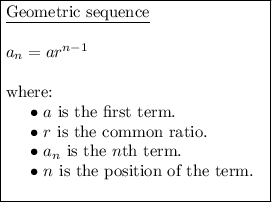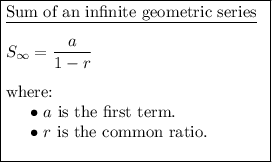Answer:


(c) Sequence converges to zero
(d) Sum converges to -54
Explanation:
Given sequence:
-36, -12, -4, ...
Since the common difference between terms is not constant, it is not an arithmetic sequence.
Divide each term by the previous term:


As the common ratio is the constant, this is a geometric sequence with common ratio (r) = ¹/₃.
Part (a)
An explicit formula allows you to find the nth term of the sequence.

Substitute a = -36 and r = ¹/₃ into the formula to write an explicit formula for the given sequence:

Part (b)
A recursive formula allows you to find the nth term of the sequence provided you know the value of the previous term in the sequence.
To obtain each term of the given sequence, divide the previous term by 3. Therefore, the recursive formula for the given sequence is:

Part (c)


Therefore, the sequence converges, and the value it converges to is zero.
Part (d)
An infinite geometric series is said to be convergent if the absolute value of the common ratio is less than 1:


To find the value to which the sum of the infinite geometric series converges, substitute a = -36 and r = ¹/₃ into the formula:


